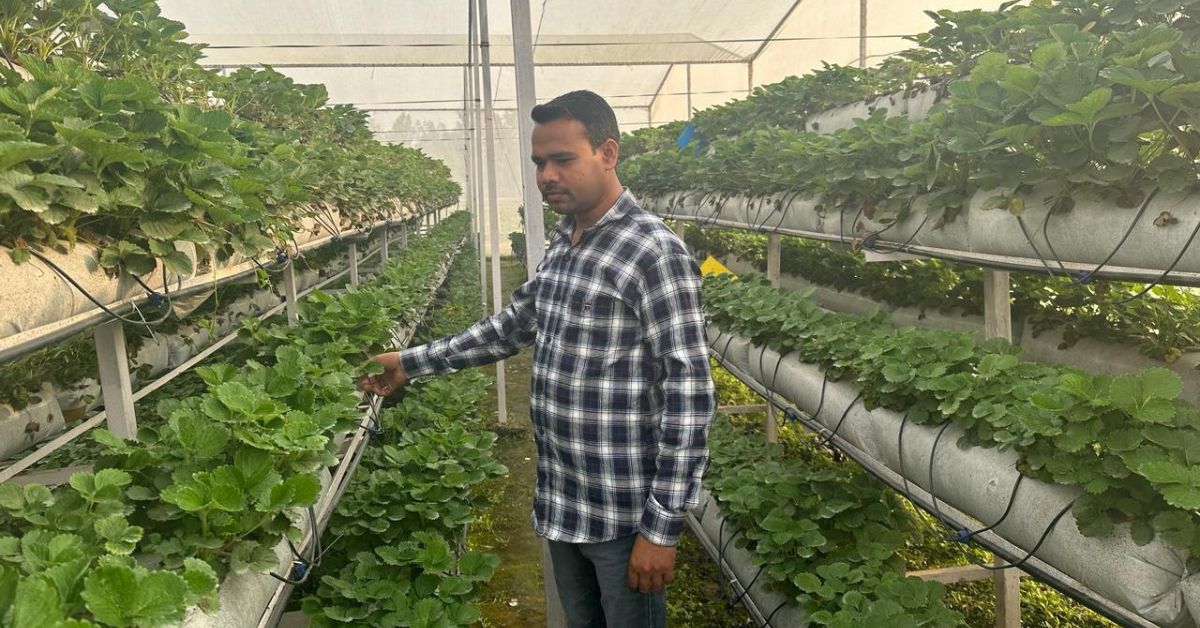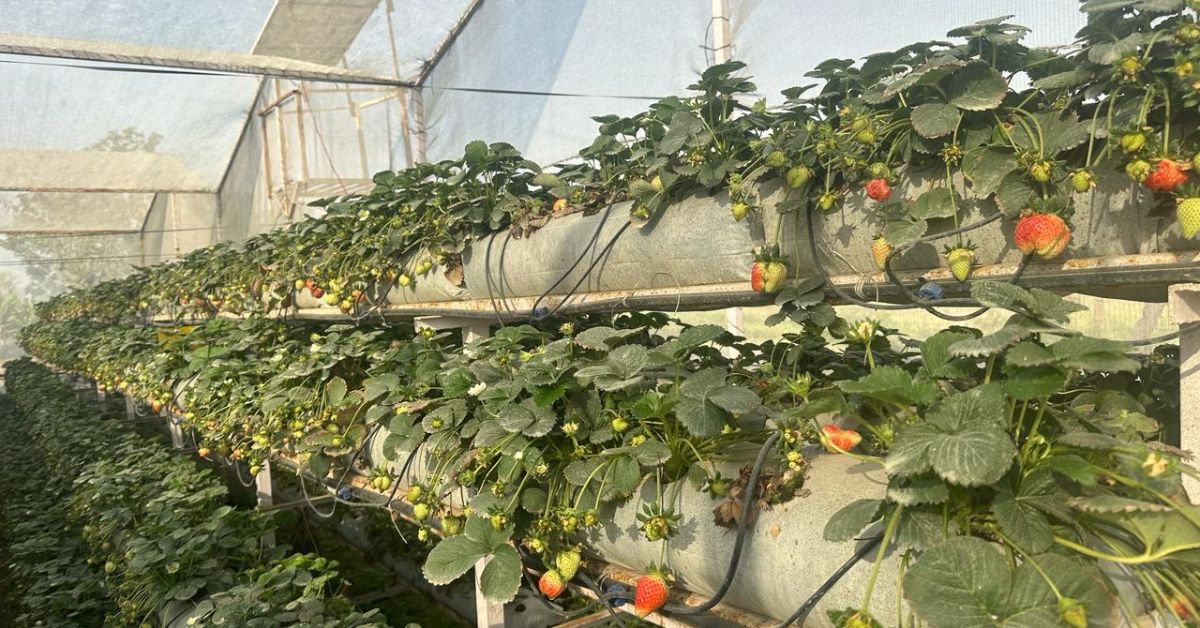‘It’s Not Rocket Science’: Farmer Uses Hydroponics to Grow Strawberries & Turn His Life Around
Encouraged by the soil-less farming technique used in Israel, Uttar Pradesh's Dheeraj Verma turned to cultivating strawberries using hydroponics. He earned Rs 3 lakh in just two months.

A couple of years back while switching channels, Dheeraj Verma came across a television programme that showcased how Israel has pioneered hydroponic farming – an innovative and efficient way to grow crops without needing soil.
This soil-less farming technique piqued the interest of the Barabanki district farmer.
“Israel has been extremely progressive in farming despite having a dry climate, limited water resources, and high population density,” he tells The Better India.
“With what they grew in an acre of land, they were able to export it to several countries. I wondered, if they were exporting produce from just one acre, why was I lagging behind despite owning 10 acres of land? I was not able to sell my produce even to the next village, let alone to the other countries,” he adds with a sigh.
Dheeraj was so fascinated by the technique that he went on to watch hundreds of related videos on hydroponics farming in Israel. His obsession led him to adopt the practice in his village Meenapur, Barabanki, which is well-known for cultivating traditional crops like wheat, maize and rice.
Early this year, Dheeraj made sales of Rs 3 lakh within two months by cultivating strawberries hydroponically.

Four problems, one solution
For the past 13 years, the BSc graduate has been growing traditional crops using conventional farming techniques. In fact, he used to grow strawberries on the open farm on five acres of land.
“The process was very cumbersome as it required a lot of land, mulching, and drip irrigation. Weeding is also a common issue in growing strawberries on land. To get rid of the unwanted grass, we had to employ agricultural labourers. The labour charges alone would cost us Rs 50,000 to remove weeds from a bigha of land,” he adds.
For Dheeraj, hydroponics farming seemed a panacea for all challenges.
In 2021, he went to Madhya Pradesh to undertake training by Dhakad Brothers to learn the hydroponics method of cultivation. “In hydroponics farming, you give nutrients to plants via water. A crop requires 13 kinds of nutrients including primary nutrients like nitrogen, phosphorus, and potassium, secondary nutrients like calcium, sulphur, and magnesium, and tertiary nutrients like iron, zinc, manganese, copper, boron, molybdenum, and chlorine. These elements act as an essential catalyst for plant growth,” he explains.
“Although I knew the technique to give these nutrients via water, I did not know the ratio in which these elements were required to be given to the crop. The training helped me learn the approach,” he adds.

5x more produce in small space
Coming back, Dheeraj established a 3,500 sq ft hydroponics set-up on his farm. Thereafter, he planted 9,000 saplings of strawberries using coco peat as a medium.
“I used grow bags and filled them with cocopeat. In these grow bags, I connected four drippers for water supply and made four small holes for drainage. Next, I planted the saplings and supplied all the nutrients to the crop with water. With this method, I water the plant at a gap of a week, instead of running the water supply 24×7. Almost 70 percent of water gets absorbed in the media for plant growth,” he says.
It took Dheeraj 1.5 months and Rs 12 lakh to build the structure.
“But it was all worth it. It is a one-time investment that reduces the overall input costs after a certain period. For five years, I do not have to worry about the maintenance of the system,” he says.
Within two months, Dheeraj was able to harvest 5 tonnes of strawberries and earned an income of Rs 3 lakh in the same period. “This method is far better than conventional farming. With hydroponics, I got five times more production in hydroponics compared to open-land farming,” he adds.
Highlighting the tasks farmers should be mindful of while adopting this method, he says, “Farmers need to monitor the hydroponics farm at least once every day. The strawberries are heavily attacked by pests and fungus. In land-based farming, we were forced to spray chemical pesticides indiscriminately. But in hydroponics, I was able to cut chemical inputs,” he says.

For this, he prepared a unique fungicide using curd.
“In one litre of curd, add 50 grams of copper wires or a copper lota (spherical vessel). Keep the content for at least 15 days until the content becomes completely blue. Take 2 ml of this mixture and dilute it in 1 litre of water. Spray the diluted content on crops once every week throughout the season. This tackles fungi attack and gives a good yield,” he explains.
“Although I am extremely happy to reap benefits by adopting this new technique, initially I made some mistakes in getting good nutrients from the market. I got misled into buying nutrients from fraud companies. This delayed my production by 1.5 months. But I am confident that I will be able to earn up to Rs 10 lakh in the next season from the same setup,” says Dheeraj, who is currently cultivating red and yellow varieties of capsicum on the hydroponics setup.
Giving his example, Dheeraj advises other farmers to explore hydroponics farming. If you found our stories insightful, informative, or even just enjoyable, we invite you to consider making a voluntary payment to support the work we do at The Better India. Your contribution helps us continue producing quality content that educates, inspires, and drives positive change. Choose one of the payment options below for your contribution- By paying for the stories you value, you directly contribute to sustaining our efforts focused on making a difference in the world. Together, let’s ensure that impactful stories continue to be told and shared, enriching lives and communities alike. Thank you for your support. Here are some frequently asked questions you might find helpful to know why you are contributing?

“This technique is not rocket science, any untutored farmer can reap handsome profits with hydroponics like me,” he suggests.
Edited by Padmashree Pande. All photos: Dheeraj Verma.
This story made me
- 97
- 121
- 89
- 167












